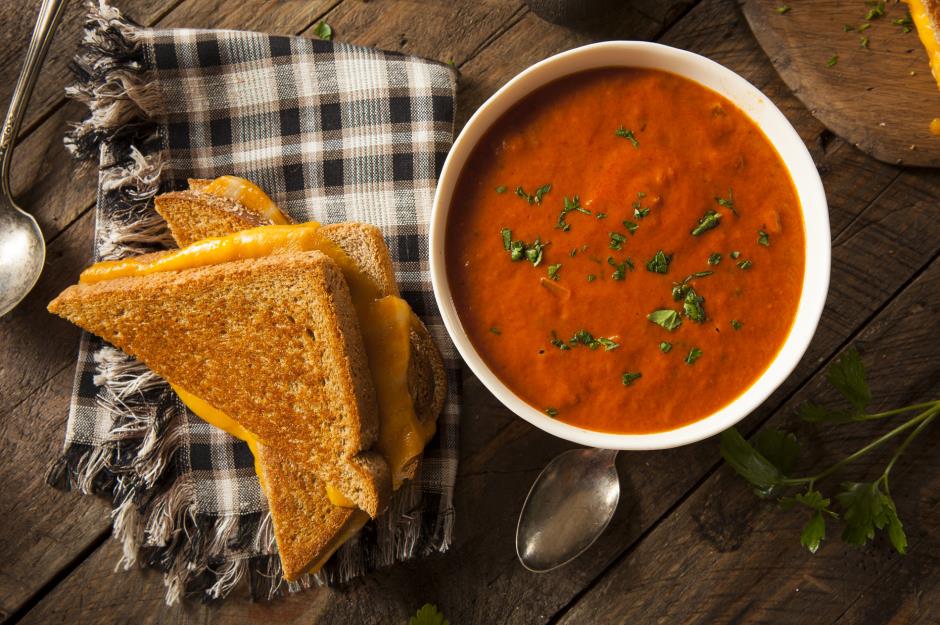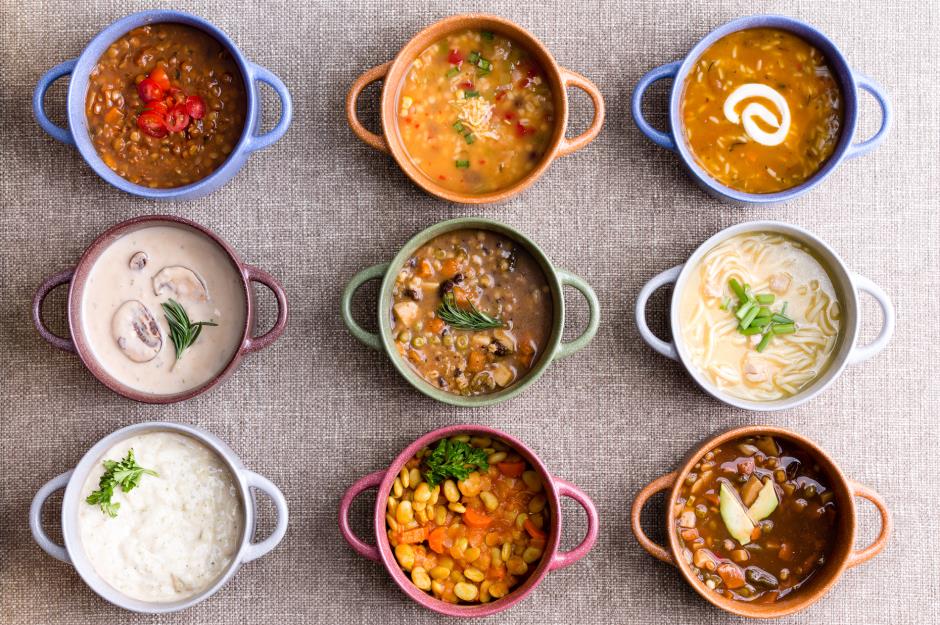25 tips for making soups that'll keep you cosy all winter
Top tips for souper soup
Find a soup to suit your mood
Know every soup base
Ace your base
A good base is essential for a soup with depth and flavour. Create a meat stock at home by slow-roasting meat or fish bones or a vegetable stock flavoured with herbs. You can use this easy-to-freeze stock base for many soups, as well as stews and risottos.
Stock cubes: yes or no?
While not as good as homemade stock, stock or bouillon cubes are useful store cupboard items. Use to create a stock rather than add to stock. They can be very salty so keep this in mind before adding any salty ingredients or extra salt. Opt for a good quality, organic brand.
Elevate veg
Roasting vegetables enhances their flavour. Buy a mix of frozen roasted or chargrilled vegetables for speed or, even better, make your own by choosing one or two items, such as red pepper and tomatoes, or by opting for a mix of vegetables such as peppers, courgettes, carrots and onions. For the simplest soup, roast them in olive oil for 30–40 minutes (at 200°C/400°F/gas mark 6) until tender. Transfer to a pan, bring to the boil with stock, simmer, allow to cool, then blend for a smooth soup or blend half, stirring in the remainder for a chunky version.
Cook in stages for the best result
While it’s easier to throw everything in a pan, breaking down the cooking process will improve soup. For example, brown meat first as it seals in flavour and renders down excess fat. Remove the meat before cooking and vegetables then throw it back in when adding liquid. Sweat onions, garlic, carrots or celery separately in oil or stock, making sure they’re cooked through before adding any more liquid. And stagger the vegetables when you add them – root veg takes longer to cook than green leaves.
Size matters
If you’re partial to bold soups use big chunks of veg or meat but if you want something daintier chop finely. Stringy greens such as kale or spinach can be tricky to eat, so if you don’t enjoy slurping up leaves chop small or blend at the end.
Make the most of umami
While a well-reduced stock goes a long way to giving soup its savouriness there are other useful ingredients. A dollop of miso paste (pictured), soy sauce or fish sauce (even in non-Asian dishes) ups the umami, as does a squeeze of tomato puree, Worcestershire sauce, or parmesan rind – even to a non-tomatoey or non-cheesy stock.
Condiments can compliment
A spoonful of Dijon or English mustard, a dash or Worcestershire sauce or a squeeze of tomato ketchup can improve soup. Mustard works particularly well with chicken, ketchup adds sweetness to a too-tart tomato soup, while a drizzle of Sriracha or chilli sauce before serving peps up milder Asian soups such chicken and sweetcorn.
Simmer down
Once soup has been brought to the boil reduce it to a simmer straight away and keep it there so the soup doesn’t over-reduce. A light simmer also prevents softer ingredients such as vegetables or pasta turning to mush.
How to save time
If you’re pushed for time, cheat. Using tinned soups as a base means half the hard work’s been done for you. Add extra meat and veg, fresh pasta or noodles to plain stock-based broths; throw in pieces of roasted poultry to a warming pan of cream of chicken soup; or blend roasted tomatoes with a tin of tomatoes, then cook through with some chicken stock and fresh basil.
Thicken up
Carbs can bulk up soup, turning it from a light meal to a substantial one. Add potatoes for a denser, heartier finish – either cook in the soup then blend, or blend in mashed potato. For a less carb-laden but creamy option puree protein-rich cannellini beans. Alternatively, a flour and butter roux base will thicken up stock, or if it’s more substance than thickness you’re after bulk up with noodles, rice, pasta, or grains such as barley, spelt or quinoa.
Know when to add carbs
If you choose to add carbs such as rice, noodles or pasta there’s no need to cook them separately; instead add towards the end of cooking. This way they’ll take on the flavour of the broth as they warm through. Don’t be tempted to add them too early, however, or they’ll become mushy.
Harness extras
Herbs, spices, garlic and citrus add an extra dimension to many dishes and soup is no different. Many Asian soups are lost without fresh garlic, ginger and chilli and a chopped coriander and mint garnish. Chinese noodle soup often contains star anise, while Italian soups benefit from a little lemon zest and basil.
Milk and cream need careful handling
Dairy can curdle if added to hot soup so it’s best to wait until the liquid has cooled before adding warmed cream or milk. Incorporate slowly, checking the taste and consistency as you do so.
Soup too salty?
It’s widely believed that a peeled raw potato placed in a too-salty soup absorbs the salt; this is partially true but there are also other ways. Adding more liquid can work, or adding something acidic such as lemon juice, tomato puree or vinegar, or sweet such as a spoonful of sugar, can tone down saltiness by balancing out flavours.
Try improvising
The great thing about soup is that it’s versatile. By all means follow a recipe (and for certain types of soup, such as French onion or tom yum, that’s necessary) but others just require your imagination and what’s in the fridge. Be creative and resourceful – add greens to chowder, ginger to courgette soup, or orzo pasta to a meat broth.
How to make soup healthier
Blended cashew nuts, Greek yoghurt or coconut milk rather than cream; roasted, protein-rich chickpeas or seeds in place of croutons; wholemeal pasta, wild rice, or ancient grains instead of white versions – these are all ways to make soup healthier. Homemade broth made from organic bones; using herbs and spices instead of salt; and thickening soup with pureed white beans rather than white potatoes are other easy wins for a more wholesome dish.
Slow cooker rules
Soup will pretty much cook itself in a slow cooker. Most recipes can be adapted though if you have any doubts there are countless slow cooker soup recipes (try this slow-cooked short rib pho). The general rule is to throw all the necessary ingredients in and, if you have the time, cook for 6–8 hours on a low heat so the flavours have a chance to shine. If you’re including rice, noodles or pasta wait until 15–30 minutes before the end of cooking (depending on the carb) before adding.
Batch-cook for convenience
If you’re making soup for four, why not double the ingredients and make it for eight, or triple it for twelve? You won’t be making much more effort (you’ll just need a bigger pot) and you’ll have homemade ready meals in the fridge or freezer for when you don’t feel like cooking. Batch-cooking and freezing works especially well for blended vegetable soups, bean soups and meat-based soups.
About serving sizes
Tempting as it is to keep spooning delicious steaming soup into a big bowl, the ideal serving size for soup is 300–500ml (1¼–2 cups) for a main course, and 200–250ml (¾–1 cup) for a starter.
Avoid explosions
If you’re blending soup be aware that the heat and steam can cause the blender lid to lift and that could mean soup on the walls, on the floor, and on you. Allow the liquid to cool a little first then hold the lid down firmly to prevent mishaps.
Keeping soup fresh
Soup can last for 2–3 days in the fridge but it needs to cool, uncovered, to room temperature beforehand.
Fuss-free freezing
Soup is a freezer-friendly food so it’s worth making more than you need, though avoid freezing very creamy or seafood soups as they don’t withstand chilling as well. Cool overnight then portion and freeze for up to two months. Toppings (sour cream, fresh herbs, croutons) should be added after the soup has been thawed and reheated.
Global soups for your repertoire
Almost every culture has a soup of sorts: Russia has borscht; there’s German wedding soup; Jewish matzo ball soup; Greek avgolemono; Chinese congee and egg drop soups; Thai tom yum; and Malaysian laksa. In Japanese cuisine ramen is ubiquitous, while nässelsoppa (nettle soup) is a Swedish delicacy, and the Scots have the wonderfully-named cullen skink. Read on for some mouthwatering recipes from around the world.
France: French onion soup
This French classic is full of texture and while pungent the cheesy topping balances it out beautifully.
Ireland: potato soup
A comforting, carb-rich and hearty soup that can be vegetarian or made with a meaty chicken stock.
Italy: Minestrone
This family-friendly Italian soup is 'souper' nutritious thanks to oodles of vegetables. Although this recipe doesn't include any, minestrone often contains a generous helping of pasta.
Mediterranean fish soup
Enriched with tomato fondue and saffron and garlic rouille, this delightful soup manages to be both rustic and indulgent.
Mexico: black bean soup
This intensely-spiced soup is not for the faint-hearted but it boldly goes where other soups dare not venture.
Scotland: Cock-a-leekie
Healthy and economical, this chicken and leek broth can be padded out with rice.
Spain: gazpacho
Fresh and flavourful gazpacho is one of Spain's greatest culinary creations. Although it's a chilled soup you don't have to wait for a hot day to enjoy it.
Thailand: chicken noodle soup
Wholesome and nutritious, though it has a creamy, coconutty base, this Thai chicken noodle soup still manages to be light on the stomach while the chillies pack a welcome punch.
USA: Chowder
A creamy taste of the sea, this thick seafood soup is synonymous with America's East Coast though it's actually European in origin.
Vietnam: pho
Herby and aromatic, with lots of lovely spices, this pho recipe uses slow-cooked beef for extra flavour.

